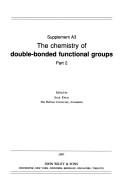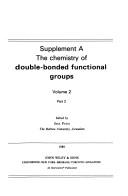| Listing 1 - 7 of 7 |
Sort by
|
Article
Abstract | Keywords | Export | Availability | Bookmark
 Loading...
Loading...Choose an application
- Reference Manager
- EndNote
- RefWorks (Direct export to RefWorks)
BROMINATION --- DOUBLE BOND --- BROMINATION --- DOUBLE BOND
Article
Abstract | Keywords | Export | Availability | Bookmark
 Loading...
Loading...Choose an application
- Reference Manager
- EndNote
- RefWorks (Direct export to RefWorks)
DOUBLE BOND --- GERMANIUM COMPOUNDS --- TIN COMPOUNDS --- DOUBLE BOND --- GERMANIUM COMPOUNDS --- TIN COMPOUNDS

ISBN: 0471959561 Year: 1997 Publisher: New York, NY : John Wiley,
Abstract | Keywords | Export | Availability | Bookmark
 Loading...
Loading...Choose an application
- Reference Manager
- EndNote
- RefWorks (Direct export to RefWorks)
Carbonyl compounds. --- Amidines --- Double bond --- Imines --- Oximes --- Unsaturated compounds

ISBN: 0471924938 Year: 1989 Publisher: New York, NY ; Chichester : John Wiley,
Abstract | Keywords | Export | Availability | Bookmark
 Loading...
Loading...Choose an application
- Reference Manager
- EndNote
- RefWorks (Direct export to RefWorks)
Carbonyl compounds. --- Alkenes --- Allylic rearrangement --- Carbonylation --- Cycloaddition reaction --- Cycloalkenes --- Double bond --- Thiocarbonyl compd --- Amidines --- Imines --- Oximes --- Unsaturated compounds
Book
Year: 1967 Publisher: Gent : RUG,
Abstract | Keywords | Export | Availability | Bookmark
 Loading...
Loading...Choose an application
- Reference Manager
- EndNote
- RefWorks (Direct export to RefWorks)
C-N- bond. --- C-O-double bond. --- C-halogen-bond. --- Energy and biological systems. --- Isomerism. --- Optical isomerism. --- Organometallic bond.
Book
Year: 1960 Publisher: Ithaca (N.Y.) : Cornell university press,
Abstract | Keywords | Export | Availability | Bookmark
 Loading...
Loading...Choose an application
- Reference Manager
- EndNote
- RefWorks (Direct export to RefWorks)
Bond angle. --- Bond strength. --- Chemical bond. --- Chemical bonds. --- Complex bond orbitals. --- Crystal structure. --- Crystallography. --- Directed covalent bond. --- Double-bond character. --- Electronegativity. --- Electronic structure of atoms. --- Formal structures. --- Interatomic distances. --- Ionic character. --- Magnetic criterion. --- Molecules. --- Partial ionic character of covalent bonds. --- Quantum chemistry. --- Relative electronegativity. --- Resonance. --- Valence bond structure.
Book
ISBN: 1400874025 Year: 2016 Publisher: Princeton, New Jersey ; Oxford, England : Princeton University Press,
Abstract | Keywords | Export | Availability | Bookmark
 Loading...
Loading...Choose an application
- Reference Manager
- EndNote
- RefWorks (Direct export to RefWorks)
In the earlier monograph Pseudo-reductive Groups, Brian Conrad, Ofer Gabber, and Gopal Prasad explored the general structure of pseudo-reductive groups. In this new book, Classification of Pseudo-reductive Groups, Conrad and Prasad go further to study the classification over an arbitrary field. An isomorphism theorem proved here determines the automorphism schemes of these groups. The book also gives a Tits-Witt type classification of isotropic groups and displays a cohomological obstruction to the existence of pseudo-split forms. Constructions based on regular degenerate quadratic forms and new techniques with central extensions provide insight into new phenomena in characteristic 2, which also leads to simplifications of the earlier work. A generalized standard construction is shown to account for all possibilities up to mild central extensions. The results and methods developed in Classification of Pseudo-reductive Groups will interest mathematicians and graduate students who work with algebraic groups in number theory and algebraic geometry in positive characteristic.
Linear algebraic groups. --- Group theory. --- Geometry, Algebraic. --- Algebraic geometry --- Geometry --- Groups, Theory of --- Substitutions (Mathematics) --- Algebra --- Algebraic groups, Linear --- Geometry, Algebraic --- Group theory --- Algebraic varieties --- "ient homomorphism. --- Cartan k-subgroup. --- Dynkin diagram. --- Isogeny Theorem. --- Isomorphism Theorem. --- Levi subgroup. --- SeveriЂrauer variety. --- Tits classification. --- Tits-style classification. --- Weil restriction. --- algebraic geometry. --- automorphism functor. --- automorphism scheme. --- automorphism. --- canonical central extensions. --- central "ient. --- central extension. --- characteristic 2. --- conformal isometry. --- degenerate quadratic form. --- double bond. --- exotic construction. --- field-theoretic invariant. --- generalized exotic group. --- generalized standard group. --- generalized standard presentation. --- generalized standard. --- isomorphism class. --- isomorphism. --- isotropic group. --- k-tame central extension. --- linear isomorphism. --- linear-algebraic invariant. --- maximal torus. --- minimal type. --- non-reduced root system. --- number theory. --- pseudo-isogeny. --- pseudo-reductive group. --- pseudo-semisimple group. --- pseudo-simple group. --- pseudo-simple k-group. --- pseudo-split form. --- pseudo-split. --- quadratic space. --- quadrics. --- rank-1. --- rank-2. --- rigidity property. --- root field. --- root system. --- scheme-theoretic center. --- semisimple "ient. --- semisimple k-group. --- structure theorem.
| Listing 1 - 7 of 7 |
Sort by
|

 Search
Search Feedback
Feedback About UniCat
About UniCat  Help
Help News
News